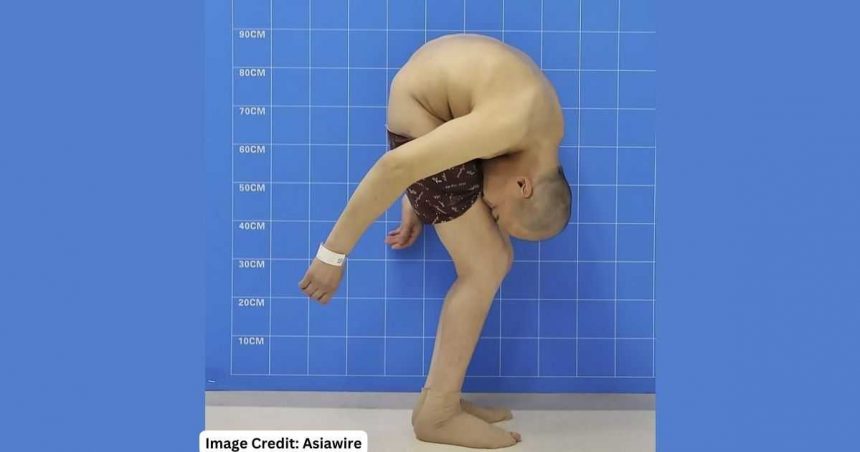Imagine the struggle of living for years with your world collapsing around you, your vision restricted to the ground beneath your feet. This was the harsh reality faced by Li Hua, known as the ‘folding man,’ as he navigated an extraordinary physical challenge. A revolutionary medical intervention has now transformed his life, offering new perspectives in both a literal and metaphorical sense. This narrative not only documents an individual’s remarkable journey but also celebrates the remarkable advancements in medical science and the unwavering human spirit to reclaim life. Join us as we peel back the layers of this inspiring tale.
Li Hua’s Early Battles and Journey to Surgery
Ankylosing spondylitis (AS) is a chronic, inflammatory rheumatic disease that predominantly affects the spine and sacroiliac joints, resulting in excruciating pain, stiffness, and limited mobility. Li Hua was afflicted by this condition at a young age, characterized by the immune system erroneously attacking healthy joints, causing inflammation and discomfort. Over time, this can lead to the fusion of vertebrae, drastically reducing spine flexibility and impacting posture, illustrated in Li’s severe kyphosis.
Research indicates that AS disproportionately affects men and has a heritability factor of over 90%, often linked to the HLA-B27 gene. This condition significantly impairs quality of life due to chronic pain and decreased mobility, posing substantial social and economic burdens. Despite affecting approximately 1.6 million people in the US alone, the pathogenesis of AS involves intricate interactions between genetic predispositions and environmental factors, making its management complex.
Medical advancements have revolutionized the treatment of AS, focusing on symptom management and preventing severe complications through nonsteroidal anti-inflammatory drugs and advanced biological treatments like tumor necrosis factor inhibitors. These treatments aim to reduce inflammation, alleviate pain, and maintain mobility, enhancing the quality of life for individuals affected by AS.
The Landmark Surgery
Li Hua’s journey, marked by severe physical limitations imposed by ankylosing spondylitis, showcases a groundbreaking achievement in spinal surgery. His narrative is a testament to a series of high-risk surgeries that not only defied medical conventions but also pushed the boundaries of surgical possibilities.
Li’s transformation commenced when he crossed paths with Dr. Tao Huiren, a leading specialist in spinal surgeries at Shenzhen University General Hospital. Given the severity of Li’s condition, Dr. Tao embarked on what he described as the “orthopedic equivalent of climbing the Himalayas.” The surgical plan was revolutionary, entailing multiple intricate procedures meticulously designed to reconstruct Li’s severely deformed spine gradually.
The series of surgeries began with breaking and realigning Li’s femurs to separate his thighs from his face, a crucial initial step to gain better access to his upper body for subsequent surgeries. This was succeeded by the meticulous adjustment of the cervical vertebrae, elevating his head and significantly improving his quality of life by offering a fresh perspective.
The third surgery targeted the most deformed segment of Li’s spine. Through a combination of innovative surgical techniques, Dr. Tao realigned Li’s spine, enabling him to lie flat for the first time in years. The final procedure involved the insertion of artificial hip joints, pivotal for Li to attain an upright posture and eventually walk with support.
Each surgical stage presented unique challenges, particularly in managing Li’s airway during operations due to his unconventional body configuration. The medical team employed inventive anesthesia techniques, highlighting the critical fusion of compassionate care and surgical precision required in such unprecedented medical circumstances.
These surgeries signify both technical mastery of spinal manipulation and the evolution of minimally invasive techniques prioritizing patient recovery and minimizing surgical risks. Li’s successful outcome serves as a beacon of hope for individuals grappling with similar debilitating conditions, underscoring the transformative impact of medical innovation on individual lives.
The bravery and resolve exhibited by Li and his medical team, coupled with cutting-edge surgical advancements, have rewritten his life story from one of immense physical constraint to one of mobility and hope. This case not only advances medical understanding but also poignantly underscores the resilience of the human spirit.
Recovery and Rehabilitation
Following a series of complex surgeries to correct his severe spinal deformities, Li Hua embarked on a critical phase of his journey – recovery and rehabilitation. This phase was just as pivotal as the surgeries themselves, involving a tailored rehabilitation program aimed at restoring his mobility and enhancing his overall quality of life.
Postoperative rehabilitation is a multifaceted approach significantly impacting the speed and success of a patient’s recovery. Enhanced Recovery After Surgery (ERAS) protocols have proven to enhance outcomes, facilitating swifter functional recovery and reducing postoperative complications. These protocols encompass preoperative education, optimized pain management strategies, early mobilization, and nutritional support, all geared toward alleviating the surgical stress and expediting recovery.
For Li Hua, postoperative rehabilitation commenced shortly after surgery, focusing on physical therapy to strengthen his muscles and stabilize his spine. Studies suggest that initiating physical rehabilitation early can lead to improved outcomes, including diminished pain and a quicker return to normal activities. Li’s regimen likely comprised a blend of endurance exercises, manual therapy, and potentially other physical agents tailored to his specific surgical interventions and his body’s response to them.
Critical to Li’s recovery was the management of risks associated with prolonged immobilization, such as deep vein thrombosis and pulmonary complications. Strategies like thromboprophylaxis and early mobilization were likely employed by the medical team to mitigate these risks and facilitate a speedier return to daily activities.
Recovering from such extensive surgeries encompasses not only physical but also psychological aspects. Patients often benefit from psychological support to cope with the significant changes to their bodies and lifestyles. For Li, the improvement in mobility and reduction in pain resulting from successful surgery and rehabilitation likely contributed to a notable enhancement in mental health and quality of life.
Li Hua’s journey exemplifies the importance of a well-coordinated recovery plan integrating state-of-the-art surgical techniques with comprehensive postoperative care and rehabilitation. His transformation from the ‘folding man’ to standing upright not only epitomizes the challenges faced by individuals with severe spinal deformities but also showcases the incredible possibilities within modern medical science to dramatically enhance lives.
Living with Ankylosing Spondylitis
Ankylosing spondylitis (AS), a chronic inflammatory condition primarily affecting the spine and large joints, significantly impacts individuals’ daily lives and well-being. The condition’s symptoms, such as severe pain and stiffness, often pose hurdles in maintaining employment and personal relationships. Many individuals with AS report difficulties in performing physical tasks and diminished productivity, profoundly affecting their work life. Women, in particular, may find these challenges impacting their work capacity more severely than men, at times necessitating job modifications.
Despite these challenges, effective management strategies can significantly boost quality of life. Treatments for AS focus on symptom alleviation and complication prevention, encompassing nonsteroidal anti-inflammatory drugs (NSAIDs), biologic medications like TNF blockers and IL-17 inhibitors, and physical therapy. These treatments aid in pain and inflammation management and preservation of mobility.
Physical therapy serves as a crucial component in AS management, with tailored exercises enhancing strength, flexibility, and posture. Emphasizing regular physical activity is key in treatment, as consistent movement helps alleviate stiffness and pain.
Support from patient advocacy groups and access to reliable health information are vital for individuals with AS. Many patients express a lack of information on managing their condition, leading to feelings of isolation and stress. Therefore, holistic care entails discussions about AS’s impact on all aspects of life, not solely physical health.
For those newly diagnosed or grappling with their condition, joining support groups can offer a sense of community and shared experience invaluable for coping. These groups provide a platform to exchange treatment experiences, practical management tips, and emotional support, reminding patients they are not alone in their journey.
Practical Tips for Managing Chronic Conditions
Navigating life with a chronic condition such as ankylosing spondylitis (AS) necessitates adjustments across various facets of life. Here are some practical tips to effectively manage the condition and uphold a higher quality of life:
Staying Active: Regular physical activity is crucial for maintaining joint flexibility and minimizing pain. Engaging in low-impact exercises like walking, swimming, or yoga can promote overall well-being and alleviate symptoms.






